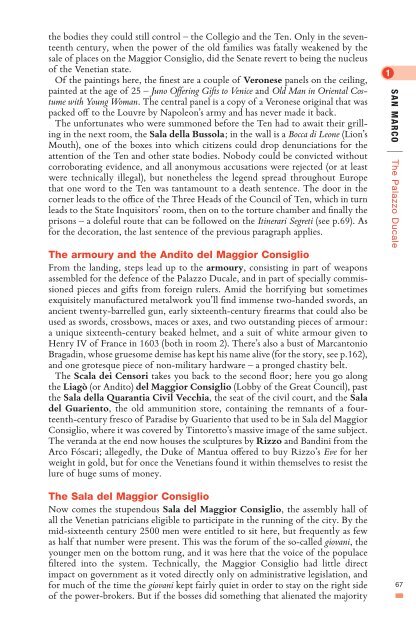You also want an ePaper? Increase the reach of your titles
YUMPU automatically turns print PDFs into web optimized ePapers that Google loves.
<strong>the</strong> bodies <strong>the</strong>y could still control – <strong>the</strong> Collegio <strong>and</strong> <strong>the</strong> Ten. Only in <strong>the</strong> seventeenth<br />
century, when <strong>the</strong> power of <strong>the</strong> old families was fatally weakened by <strong>the</strong><br />
sale of places on <strong>the</strong> Maggior Consiglio, did <strong>the</strong> Senate revert <strong>to</strong> being <strong>the</strong> nucleus<br />
of <strong>the</strong> Venetian state.<br />
Of <strong>the</strong> paintings here, <strong>the</strong> finest are a couple of Veronese panels on <strong>the</strong> ceiling,<br />
painted at <strong>the</strong> age of 25 – Juno Offering Gifts <strong>to</strong> <strong>Venice</strong> <strong>and</strong> Old Man in Oriental Costume<br />
with Young Woman. <strong>The</strong> central panel is a copy of a Veronese original that was<br />
packed off <strong>to</strong> <strong>the</strong> Louvre by Napoleon’s army <strong>and</strong> has never made it back.<br />
<strong>The</strong> unfortunates who were summoned before <strong>the</strong> Ten had <strong>to</strong> await <strong>the</strong>ir grilling<br />
in <strong>the</strong> next room, <strong>the</strong> Sala della Bussola; in <strong>the</strong> wall is a Bocca di Leone (Lion’s<br />
Mouth), one of <strong>the</strong> boxes in<strong>to</strong> which citizens could drop denunciations for <strong>the</strong><br />
attention of <strong>the</strong> Ten <strong>and</strong> o<strong>the</strong>r state bodies. Nobody could be convicted without<br />
corroborating evidence, <strong>and</strong> all anonymous accusations were rejected (or at least<br />
were technically illegal), but none<strong>the</strong>less <strong>the</strong> legend spread throughout Europe<br />
that one word <strong>to</strong> <strong>the</strong> Ten was tantamount <strong>to</strong> a death sentence. <strong>The</strong> door in <strong>the</strong><br />
corner leads <strong>to</strong> <strong>the</strong> office of <strong>the</strong> Three Heads of <strong>the</strong> Council of Ten, which in turn<br />
leads <strong>to</strong> <strong>the</strong> State Inquisi<strong>to</strong>rs’ room, <strong>the</strong>n on <strong>to</strong> <strong>the</strong> <strong>to</strong>rture chamber <strong>and</strong> finally <strong>the</strong><br />
prisons – a doleful route that can be followed on <strong>the</strong> Itinerari Segreti (see p.69). As<br />
for <strong>the</strong> decoration, <strong>the</strong> last sentence of <strong>the</strong> previous paragraph applies.<br />
<strong>The</strong> armoury <strong>and</strong> <strong>the</strong> Andi<strong>to</strong> del Maggior Consiglio<br />
From <strong>the</strong> l<strong>and</strong>ing, steps lead up <strong>to</strong> <strong>the</strong> armoury, consisting in part of weapons<br />
assembled for <strong>the</strong> defence of <strong>the</strong> Palazzo Ducale, <strong>and</strong> in part of specially commissioned<br />
pieces <strong>and</strong> gifts from foreign rulers. Amid <strong>the</strong> horrifying but sometimes<br />
exquisitely manufactured metalwork you’ll find immense two-h<strong>and</strong>ed swords, an<br />
ancient twenty-barrelled gun, early sixteenth-century firearms that could also be<br />
used as swords, crossbows, maces or axes, <strong>and</strong> two outst<strong>and</strong>ing pieces of armour:<br />
a unique sixteenth-century beaked helmet, <strong>and</strong> a suit of white armour given <strong>to</strong><br />
Henry IV of France in 1603 (both in room 2). <strong>The</strong>re’s also a bust of Marcan<strong>to</strong>nio<br />
Bragadin, whose gruesome demise has kept his name alive (for <strong>the</strong> s<strong>to</strong>ry, see p.162),<br />
<strong>and</strong> one grotesque piece of non-military hardware – a pronged chastity belt.<br />
<strong>The</strong> Scala dei Censori takes you back <strong>to</strong> <strong>the</strong> second floor; here you go along<br />
<strong>the</strong> Liagò (or Andi<strong>to</strong>) del Maggior Consiglio (Lobby of <strong>the</strong> Great Council), past<br />
<strong>the</strong> Sala della Quarantia Civil Vecchia, <strong>the</strong> seat of <strong>the</strong> civil court, <strong>and</strong> <strong>the</strong> Sala<br />
del Guarien<strong>to</strong>, <strong>the</strong> old ammunition s<strong>to</strong>re, containing <strong>the</strong> remnants of a fourteenth-century<br />
fresco of Paradise by Guarien<strong>to</strong> that used <strong>to</strong> be in Sala del Maggior<br />
Consiglio, where it was covered by Tin<strong>to</strong>ret<strong>to</strong>’s massive image of <strong>the</strong> same subject.<br />
<strong>The</strong> ver<strong>and</strong>a at <strong>the</strong> end now houses <strong>the</strong> sculptures by Rizzo <strong>and</strong> B<strong>and</strong>ini from <strong>the</strong><br />
Arco Fóscari; allegedly, <strong>the</strong> Duke of Mantua offered <strong>to</strong> buy Rizzo’s Eve for her<br />
weight in gold, but for once <strong>the</strong> Venetians found it within <strong>the</strong>mselves <strong>to</strong> resist <strong>the</strong><br />
lure of huge sums of money.<br />
<strong>The</strong> Sala del Maggior Consiglio<br />
Now comes <strong>the</strong> stupendous Sala del Maggior Consiglio, <strong>the</strong> assembly hall of<br />
all <strong>the</strong> Venetian patricians eligible <strong>to</strong> participate in <strong>the</strong> running of <strong>the</strong> city. By <strong>the</strong><br />
mid-sixteenth century 2500 men were entitled <strong>to</strong> sit here, but frequently as few<br />
as half that number were present. This was <strong>the</strong> forum of <strong>the</strong> so-called giovani, <strong>the</strong><br />
younger men on <strong>the</strong> bot<strong>to</strong>m rung, <strong>and</strong> it was here that <strong>the</strong> voice of <strong>the</strong> populace<br />
filtered in<strong>to</strong> <strong>the</strong> system. Technically, <strong>the</strong> Maggior Consiglio had little direct<br />
impact on government as it voted directly only on administrative legislation, <strong>and</strong><br />
for much of <strong>the</strong> time <strong>the</strong> giovani kept fairly quiet in order <strong>to</strong> stay on <strong>the</strong> right side<br />
of <strong>the</strong> power-brokers. But if <strong>the</strong> bosses did something that alienated <strong>the</strong> majority<br />
san marco<br />
|<br />
<strong>The</strong> Palazzo Ducale<br />
67







